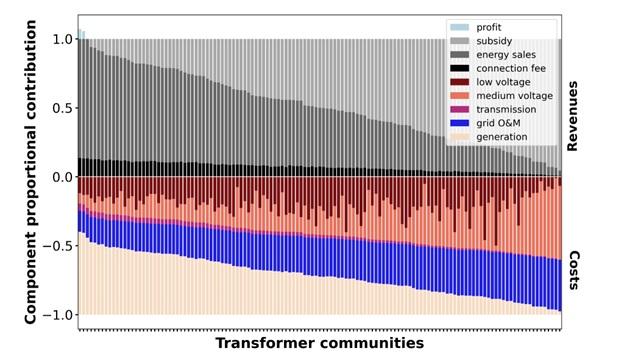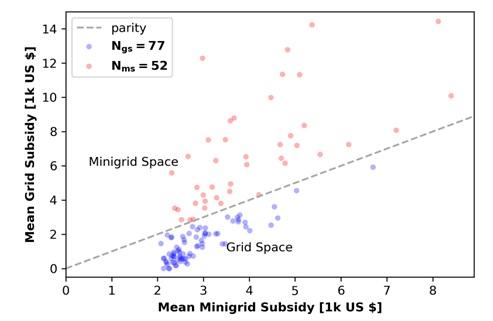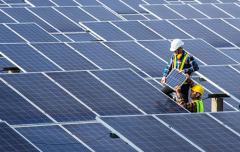Stretching budgets by not stretching power lines: Faster and cheaper electricity access through careful subsidy allocation in Africa
By: Lefu Maqelepo, Rochester Institute of Technology; Nathan Williams, Rochester Institute of Technology; and Jay Taneja, University of Massachusetts – Amherst
This article is a summary of the authors’ recent research Rural electrification subsidy estimation: a spatial model development and case study
In the race towards universal electricity access, decentralized technologies have garnered a lot of attention as alternatives to the centralized, grid-based incumbent. However, despite the fanfare around decentralized technologies like solar home systems and mini-grids[i], grid extension has largely remained the default approach for national electrification programmes in Sub-Saharan Africa, even in settings where taking an “integrated” electricity access planning approach is necessary.
Although some distribution utilities are private (e.g., UMEME in Uganda) and some governments are investing in decentralized approaches (e.g., KOSAP in Kenya), an overwhelming majority of investments in electricity access expansion projects in SSA still flows to grid extension programmes run by national, publicly owned electric utilities[ii]. Most of these national utilities are highly subsidized by public investments or loans; the World Bank finds that only two of 39 African electric utilities are financially sustainable for capital and operational expenditures without government support.
Further, most utilities in Africa only connect a small fraction of the rural populations in their respective countries. Extending grid access to these sparse rural customers requires enormous upfront subsidies - from USD 500 to USD 4,000,[iii] with limited revenues from increased sales of electricity. We acknowledge that large subsidies have always been needed to achieve universal electricity access[iv] and note that expansion of rural electrification is off the pace to reach universal electrification by 2030[v]. While more money invested in rural electrification can accelerate expansion, there will always be competing priorities for governments to balance against. Can current levels of investment in rural electrification be allocated in a way that reaches more people and does so faster?
To answer this question, we undertook analyses of grid extension projects in Kenya and found that using distributed electrification in addition to grid extension would have resulted in a 9.2 percent higher rate of electrification than grid extension alone at the exact same cost.
To arrive at this conclusion, we first needed to understand how money has been invested in rural electrification to this point. However, expenditures on rural grid expansion and operation are seldom analyzed jointly, with the literature on electricity subsidies almost exclusively focused on the former and not the latter. Electricity systems are replete with cross subsidies between higher-revenue and/or cheaper-to-connect consumers and their lower-revenue and/or expensive-to-connect peers resulting in large implicit subsidies flowing to rural communities. This arrangement made sense when the grid was the only option for electrification; however, the emergence of competing utilities providing decentralized electrification systems -- which may be able to meet consumers’ domestic needs at a lower cost to provision, depending on the setting – calls for deeper examination of how subsidies are allocated in electricity systems.
In a study that cut across seven countries and three continents, Duke Energy Access Project researchers found that connection subsidies for rural households averaged USD 1,300 per connection. But averages only tell part of the story, obscuring the opportunity to accelerate electricity access. Understanding the full distribution of these subsidies is critical to understanding how many rural connections could have been made at lower cost using decentralized alternatives like mini-grids, which obviate the need for medium-voltage distribution lines. The money saved from selecting the cheapest alternative for each setting can be reallocated to connect more communities, resulting in an expansion of electricity access at the same cost.
To show how this works in practice, we use detailed geospatial grid electricity infrastructure, cost, and revenue data for 129 rural communities in Mombasa County, Kenya to estimate subsidies per connection at the level of distribution transformers.
For each transformer community, we estimated the cost of transmission and distribution infrastructure based on geospatial network data. Transmission costs per connection are obtained by averaging these costs across Kenya Power’s entire customer base. Medium voltage costs are allocated by distributing shared infrastructure costs weighted by the number of downstream connections. Revenues generated by each connection are estimated based on Kenya Power connection fees, tariffs, and electricity consumption patterns in rural Kenya for customers with different years of connection[vi]. The net positive difference between the net present value of costs minus revenues for each transformer community, projected over 30 years, is taken as the “implicit” subsidy provided to customers connected in each transformer community.





